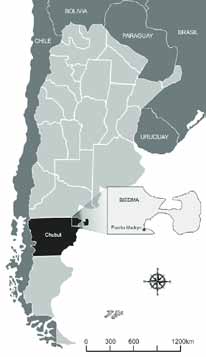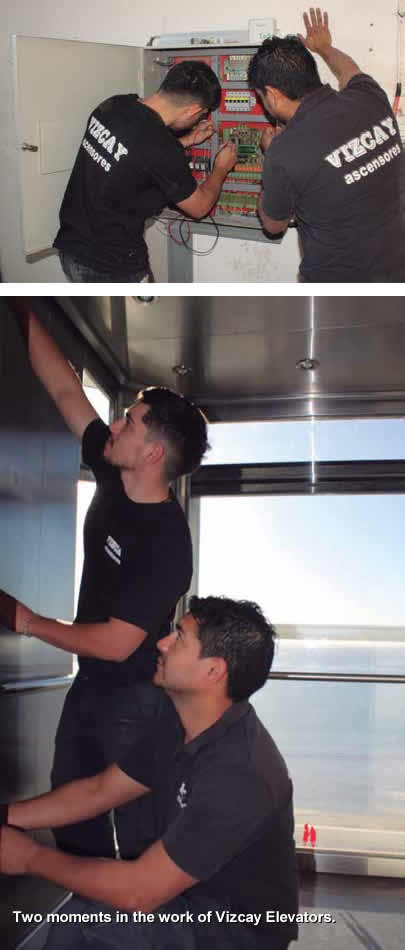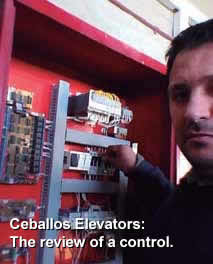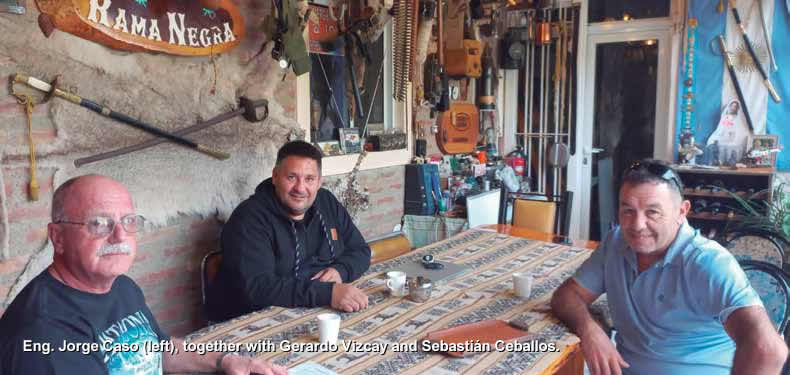
Elevators of our Patagonia
Eng. Jorge Caso*
Our far south has its elevators and its professionals.The area has its own characteristics and its particular needs. For this reason, this exclusive interview of Eng. Jorge Caso for Revista del Ascensor, carried out with two companies in the region, is especially interesting for certain issues that require the industry attention.
It seemed important to me to know some information about the number of elevators in Puerto Madryn. So I consulted the Department of Private Works from the City Hall, where I was informed that in Puerto Madryn there would be close to 390 equipments installed and in operation, plus between 15 and 20 are in the process of being installed.
Puerto Madryn is the city with the largest amount of elevators in the Province of Chubut, since Rawson and Trelew maintain, as a priority, the low-rise construction, and although Comodoro Rivadavia leads the number of inhabitants, has ranked second in terms of vertical transport.
In Puerto Madryn, the first elevators were installed in the DUC building, at the end of the ’70s. Since then, the growth of the city never stopped, and that benefited the high buildings development and, therefore, the rise of companies linked to Vertical Transport.
Ceballos and Viscay Elevators
I met with Sebastián Ceballos and Gerardo Vizcay, owners of the two companies in the sector that carry out activities in the city.
Ascensores Ceballos, (owner Sebastián Ceballos), has been in Madryn for 12 years and belongs to three owners in partnership. It has four employees and performs equipment maintenance and start-up services, as well as industrial services in general. Even though the strength of the company is maintenance, it also carries out modernizations. Now it does not carry out the installation of new elevators.
Ascensores Vizcay, whose owner is Gerardo Vizcay, is dedicated to assembly, maintenance, and modernization. It has been operating since 2005, continuing with the former venture of Carlos Galván. It has 11 employees, pursuing the goal of consolidating the brand and its own product in the market.
Eng. Jorge Caso: – Are they modern facilities or is it an average elevator fleet?
Ascensores Ceballos: I consider that it is a medium fleet of elevators; the technology that the owner acquires in Madryn is not an innovative one. There are no old or obsolete facilities left, all control boards have been replaced by modern electronics.
Ascensores Vizcay: The elevator fleet is made up of a lot new equipment. We offer variable frequency technology, touch keypads, etc. Some cabins have been preserved from old elevators, most of them having been modernized in terms of panels, traction cables, button panels, and electrical installation. The telescopic doors were eradicated in 2010 by Municipal Ordinance. There are no tall buildings, so speeds are in the order of 60 m/m.
Eng. Caso: – Does the rigorous climate require a different maintenance from that of an elevator, let us say of CABA?
A.V.: – We have serious issues, sometimes, with the hydraulic elevators due to the low temperatures, because of the oil. No matter how many heaters are placed, they are uneven in the early hours of the day. In 2011, we suffered from the volcanic ash from the Puyehue Volcano, which affected switches and facilities in general by completely invading the machine rooms. In summer, due to the very high temperatures prevailing, the engine rooms boil. But I believe that cross ventilation is not necessary today with the type of variable frequency machines with which we work; The machine and brake do not heat up, it was different with the old one-speed machines, but now that does not happen.
A.C.: – Another problem in our area is the Patagonian dust. Here always are present and prevailing the westerly winds that are capable, in a few hours, to fill any machine room and complete installations with dust. The recently cleaned guides can be covered again with dust from one day to the next. The controllers do not come prepared for soil in suspension; the drives begin to vibrate, the contactors and fans fail, and there are no IP65 or 67 boards, with which we could avoid the dust problem.
Eng. Caso: – At such a distance from the manufacturers, how do you get spare parts?
A.V.: – Orders are made via email. The shipments get to Madryn by transport since almost all of the suppliers are located in Buenos Aires. For specific materials, we travel to the headquarters in CABA.
A.C.: – Orders are made by phone or email. We have a stock of the most common consumables, to avoid the lacking of spare parts because of distance. The most specific is requested and they send it by transport or by jet pack for urgent things. Any trip to Buenos Aires is used to return with the truck filled with spare parts.
Eng. Caso: -What is the average number of floors built in the area?
A.C.: – The average in the city is around five or six floors. In hydraulics, the average is four stops, and in electromechanical we are between eight and nine stops.
A.V.: – Buildings with more than 10 floors, that is, 30 meters high, are not allowed here, which gives these average values.
Eng. Caso: – Are the Regulations and Ordinances in Madryn the same as those applied in CABA?
A.V.: – Puerto Madryn has its own ordinance that was promulgated in 2007, based on Ordinances from other provincial and/or municipal jurisdictions. Given the advancement of technology and new materials, it would have to be updated in regarding securities, keypads, electronics, and things that in 2007 were not so common. It would be important to modify and update local legislation according to how work is currently done.
A.C.: – We believe that the Ordinance should be improved regarding technology. Honestly, I am not concerned about the legislation of CABA, since our scope of work is Puerto Madryn and our work is carried out based on this Ordinance. Originally it was perhaps based on existing ordinances, but I don’t know how it is currently in Buenos Aires.
Eng. Caso: – And maintainers, do they follow the same rules as those from other regions? Are there municipal inspections? Do you work properly?
A.V.: – Here, maintainers comply with the rules imposed by the Ordinance in terms of the frequency of visits and tasks to be carried out. In addition, the requirements are established to keep valid our maintainer’s permit. An Inspection Book is signed, and we have inspections. However, I insist that we need our Ordinance to be looked over. Our maintainer’s permit is renewed every five years, and that is when we must present all the company documentation again.
We are submitted to municipal inspections when setting up equipment, to verify the signing of inspection books; we have to hand in documentation of the RC insurance (civil liability insurance) contracted, and we are requested for payments done.
Eng. Caso: – What figures are we talking about when we talk about mandatory insurance for elevator maintenance companies?
A.V.: – 28,910,000 pesos for the company, 33,000,000 pesos for the owners association and 4,800,000 for each additional elevator.
Eng. Caso: – What does an average facility require today? Automatic or semi-automatic doors, barriers of light, weighers? Do you do something in order to save energy?
A.V.: – In new installations, automatic doors are requested, and multi beam barriers, load weighers, etc. We install variable frequency to reduce wear and try to save considerable energy. In the old equipment, we have installed variable frequencies in all of them.
A.C.: – There was an improvement to the Ordinance in 2020, which contemplates the mandatory nature of double contact locks, ceiling keypad cabin, emergency light in the cabin and machine room, load weighers, multi beam barriers, etc. The current maneuvers contribute to the energy saving of the equipment. We would make it too modifying some issues of the engine rooms.
Eng. Caso: – What can you tell me about the professional staff and its training.
A.V.: – In our case, most of the staff are technicians, and we take advantage of each of the trips to Buenos Aires to do training in some companies, which deliver courses on its products
A.C.: – Only one member of the staff is not a technician, the rest are. We train in Buenos Aires and/or in Córdoba, depending on the existent offers. We carry out private training.
Eng. Caso: – do you have a percentage calculation s of the updated facilities you have carried out?
A.V.: – After taking over the company we modernized 100% of the control boards and change them to electronic ones; regarding the machines, traction wires, and doors, they have already been replaced on it majority.
A.C.: – We have replaced all the controllers with electronic ones, also traction wires, we have only two old machines left but they have VVVF, the rest has been superseded.
Eng. Caso: – Has the company itself experienced growth? In what periods?
A.V.: – Yes, of course, the growth of the company accompanied the growth of the city. We grew up together with the need of the works that needed to be done.
A.C.: – The Company grows at the rate of population density growth. The demand of the city requires training based on technology. We must adapt to the new.
Eng. Caso: – Do you assemble new equipment?
A.C.: – We do not carry out installations at present.
A.V.: – Yes, we install our own equipment with our brand.
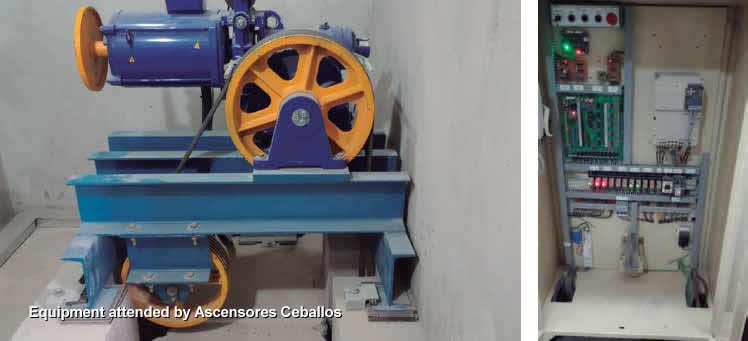
Eng. Caso: – Do you represent any manufacturing company located outside the province?
A.V.: – At other times, we did. At this moment, we install our own equipment imposing the brand.
A.C: – No, we do not.
Eng. Caso: – Do you work in any other city in the Chubut River valley? Do they have any legislation there?
A.V.: – Yes, we provide service in Trelew and Rawson, but there-there is no legislation and therefore no requirements from the municipalities. We work following the Madryn Ordinance.
A.C.: – We work in Trelew, where there is no kind of legislation.
Eng. Caso: – How is your relationship with the Elevator Chambers and/or the Federation?
A.C.: – I believe that the Chambers and any entity that regulates the activity at the national level should give talks and participate to the rest of the provinces, addressing not only the maintainer’s companies but also the society as a whole. We from our position, sometimes we cannot defend our work, our workforce, because we do not have enough support.
A.V.: – Basically, being taken into account. I consider that we are not taken into account at all. Out of Buenos Aires, there are many companies and a lot of work.
For example, Neuquén, Bariloche, Madryn, and La Rioja, have grown a lot, and Buenos Aires is not taken us into account, we never received any invitation or participation for training from Buenos Aires with regarding the rest of the country.
PUERTO MADRYN, DIVING CAPITAL CITY
The city of Puerto Madryn is located northeast of the province of Chubut, Argentina, and on the shores of the Golfo Nuevo, which is between the Peninsula de Valdés to the north and Punta Ninfas to the south. The landscape is a plateau, forming on the coast cliffs and pebble and sandy beaches. It is the head of the Viedma department. Located in front of the Argentine Sea in the Atlantic Ocean, its population in 2023 is approximately of 127,914 inhabitants. It is considered the gateway to the Valdés peninsula, declared in 1999 as a World Heritage Site by UNESCO, and one of the most important tourism centers in the entire region and the country is considered the national capital of Diving. The city population increase was almost 40,000 people since the last census in 2010. The three great pillars of the economy of this city are the industrial park (heavy and light, including aluminum production), fishing activity, and tourism. In 1974, the company ALUAR (Argentine Aluminum) settled there since its location favored exports and imports that are carried out by sea. The company employs more than 1,700 people and is the only primary aluminum producer in the country and the largest in South America. The fishing activity is favored by the presence of two piers, one of them dedicated exclusively to the aluminum industry, entry and exit of raw and manufactured materials, and fishing. The second dock houses part of the fishing fleet, and the dozen cruise ships that dock annually in the summer as a must-see tourist spot in Patagonia. In winter, excursions are made to watch the right whale, dolphins, bottlenose dolphins, penguins, sea elephants, and birds, among others. During the summer season, the beaches are very crowded, where in addition to sunbathing and water, water sports such as kayaking, canoeing, windsurfing, kitesurfing, and motorbike-skiing, among others, are practiced. The San José and Golfo Nuevo gulfs are mainly visited for “submarine baptisms”. Puerto Madryn is called the “National Diving Capital”. Puerto Madryn has university institutions of high-level programs of great importance. In the city, we find a National Technological University delegation (Chubut UTN Regional Faculty), and there is the University of Chubut delegation.
*As a brief review of the long experience of Eng. Jorge Caso, we will say that in CABA, where he is from, he worked as a technical representative, was the owner of a maintenance company, and worked with the current Health Ministry of CABA to take charge of the maintenance of the elevators of the 33 hospitals of said city. In 2005, he moved to the city of Puerto Madryn where he lives today and where he himself declares, “I was fortunate to be able to provide service to the Municipality of Puerto Madryn, where there was an Ordinance that had never entered into force, something very elementary. There they gave me an opportunity to generate a local Ordinance, of our own, made to our taste, taking the existing Ordinances’ background. I inspired myself in the Ordinances of Buenos Aires and La Plata cities and took parts of the Mar del Plata city Ordinance, too, and then adapted to our local needs. This Ordinance was then approved by the Deliberative Council of Puerto Madryn in 2007 under the number 6633 of the year 2007 of the Municipality of Puerto Madryn”.
